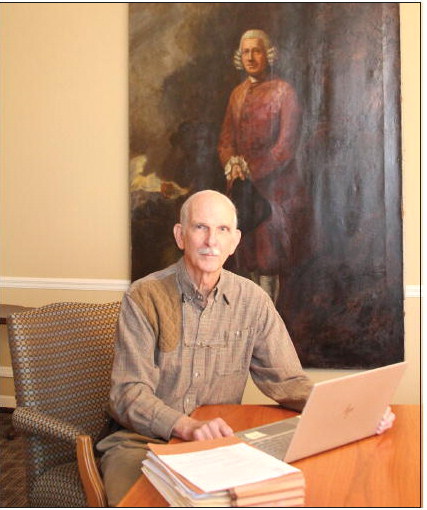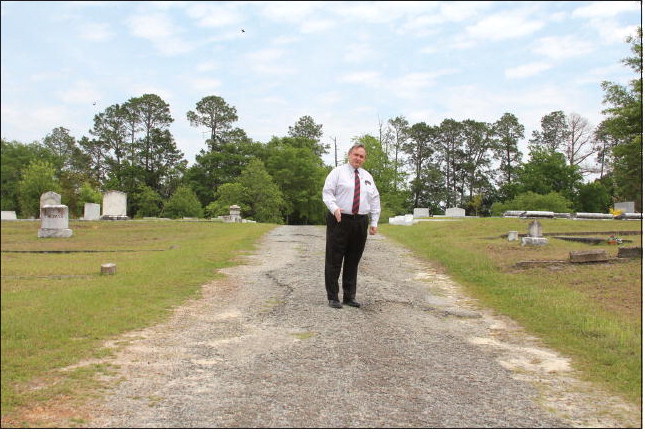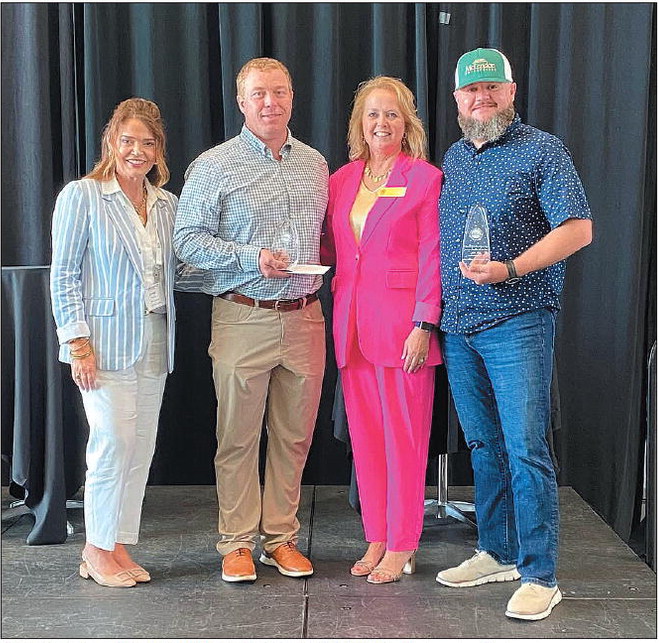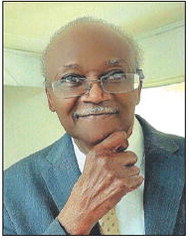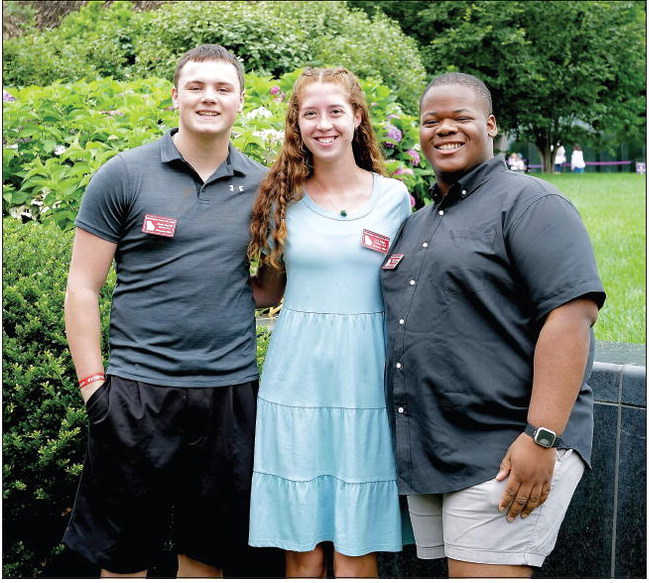continued from page plots at ….
continued from page
plots at Pinecrest still tend them; but, in many cases, no family members are left to oversee this work.
In 1984, a group of concerned citizens raised funds and established a Trust, which named the Mayor and City Council as Trustees. The intent was that interest from the Trust be set aside for the future maintenance of Pinecrest, but through the years, this resource has become insufficient to sustain care of the cemetery. The City of Vidalia stepped in to address the lots that have become derelict, mowed grass in common areas, and repaired potholes on the gravel roads.
In the 40 years Hall has been in the funeral home business, he has conducted or assisted some 1,200 services at Pinecrest, and has developed an appreciation for its history. There are an estimated 4,200 burials at Pinecrest, including many of the community’s founding members.
“If your family has lived in Toombs County for a hundred years, chances are you have relatives buried at Pinecrest. That is why people should care about Pinecrest — to honor their loved ones,” Hall said. Hall’s family first came to the Altamaha River area in the 18th century and he, too, has relatives buried at Pinecrest.
Aside from family ties, there are also the aesthetic and historic aspects of the site. “It is a resource for people interested in genealogy. People may come here to visit the graves of the ancestors, and maybe the only places they will see are Pinecrest and the convenience store where they buy gas. We want to put our best face forward,” Hall said of the cemetery’s appearance. After years of navigating the cemetery’s bumpy roads, Hall believed a paving project was a good place to begin.
Resurgence of Community Interest Soon after he became aware of Hall’s campaign, local businessman and historian John Ladson III decided to look into forming a committee of citizens with a mission of assessing the present condition and status of Pinecrest. Ladson, the son John Ladson, Jr., who founded the Ladson Genealogical Library in Vidalia, has a keen interest in history as well as in the future of the cemetery. Ladson’s parents and grandparents are interred in a diamond-shaped plot near Pinecrest’s entrance. “It took Ron’s initiative to spark an idea,” Ladson said of Ron Hall’s campaign to pave the roads at Pinecrest. In the last few months, several local residents, whose backgrounds range from community development and public relations to the practice of law and private business, agreed to join Ladson in his endeavor. The committee includes Ron Hall, as well as retired local attorney Charles Andrew, who was a member of the 1984 committee. Others are Andy Thompson, Bill Bedingfield, Connie Williams, Dent Temples, Elizabeth Harvill, Fred Godbee, Gregory Johnson, Harry Moses, John Warthen, Larry Thelkeld, Reid Threlkeld, and Tonya Parker. Mary Lou Henry, executive assistant to John Ladson, will assist the committee, as well as local genealogist and librarian Stacy Wright. The group is known as Pinecrest Committee II, in deference to the first committee formed in 1984. “A city cemetery is a monument to its greatness and a repository for its history,” Ladson commented. In the case of Pinecrest, many of the city’s founding members are buried there, including its first mayor, W.T. Jenkins. The cemetery’s significance even extends beyond Vidalia to the surrounding communities. The co-founder of Brewton Parker College in Mount Vernon, Dr. J.C. Brewton, is also buried at Pinecrest. “I venture to say that most of the movers and shakers of the community are interred at Pinecrest,” Ladson avowed.
Recent research by Charles Andrew has shed a lot more light on the origins of the cemetery. For many years, the cemetery was associated with the Murchison family, which had a funeral home in Vidalia for several generations. “That was certainly true, but we suspected the City of Vidalia had an earlier connection and we couldn’t prove it until recently.” Andrew’s diligent efforts uncovered documents verifying that as early as early as 1905, when Toombs County was created, local leaders saw a need for a cemetery. “Now we know that Pinecrest was started by the City of Vidalia when 8 to 9 acres were acquired (in 1907) and that Mayor Jenkins himself in his capacity as president with one of the early banks deeded that property to the city.” While it is not yet determined how the bank came into possession of the land that would form the nucleus of the cemetery, it is fact that the property was known as the Vidalia Cemetery and is so described in some of the old deeds, Ladson explained. Later, the Murchison family acquired land and expanded the site over time, as did the Tollison family. Records show that the City of Vidalia sold cemetery lots between 1907/1908 to about 1963.
“I have been concerned about the condition of cemetery roads, the and entrance, and other things. This is not in any way to denigrate the City of Vidalia. We are lucky to have had their help with all three cemeteries. The roads need work and main gate is damaged. I would like to see efforts broadened beyond the roads. We need to take a look at the whole situation,” Ladson said, pointing out that the road paving project is an ongoing, separate campaign.
Committee Mission
The mission of the 2021 committee includes identifying Pinecrest’s short and long-term needs, and raising funds and working with city officials to “maintain and safeguard the operation, appearance and serenity of the Pinecrest burial grounds.”
The committee members hope that the template developed for improvement oversight and maintenance of Pinecrest will benefit two other historic properties within the city limits: East Park at Grand and Fourth Streets, an Af- continued from page
rican-American Cemetery, and the Old Vidalia Cemetery, also known as the old McMillan Family Burial Grounds and the Primitive Baptist Church Cemetery, on Church Street.
The committee’s ambitious action plan begins with examining the work of the 1984 committee to determine what was accomplished. The committee will also seek answers to the critical questions: what are the exact boundaries of the cemetery and who actually owns it? The committee will also: study the Pinecrest Trust and explore its original intent and future application; seek to identify the cemetery’s capital and operational problems; and set up lines of communications with city officials, share concerns, and involve them in the process of determining Pinecrest’s future.
Objectives include: Repairing/replacing the main entrance gates and restoring entrance landscaping; Repaving the road
system;
Obtaining a bound –
ary survey; Working with the City of Vidalia to free up Trust funds for future cemetery improvements, and recommend a plan to the City for the undeveloped land held by it and the Trust; Establishing a perma nent standing committee to periodically inspect the grounds and recommend requisite action. Long-term projects might include: Developing a land use and landscape plan; Providing be(er se curity and fencing with automatic gates; Creating a digital inventory of graves and a directional map, and placing directional signing for streets within the cemetery; And, developing a plan for promoting future gifts and funding, including an annual fundraising event.
Ladson illustrated the task that lies before the Committee. “The first part is trying to learn the history of the cemetery and what has gone before us.” One of the key efforts of the 1984 Committee was to assess and improve maintenance. “That Committee did a tremendous amount or work and good. They formed a Trust and raised around $85,000 and added a bequest of $50,000 from the Murchison family. All total, the Committee put together about $135,000.”
Ladson said the Trust was set up so that income earned on the trust was turned over to the City of Vidalia for maintenance. “At the time, they thought that was sufficient to carry the maintenance into the future, but two things happened: cost of maintenance went up, and in 1984, the prime rate was 10.75%, Today, that rate is 3-4 %. The earning potential on that money declined and only a pittance comes out of it now.”
Ladson said there is about $160,000 in Trust now. “That is not enough money to take and put with a money manager and put into diversified portfolio, stocks, bonds, or whatever. That is not enough to do what the 1984 Committee contemplated.”
He said the present Committee is hoping to work with the City of Vidalia to explore how the Trust might be modified to make funds more available. The Trust that was established in 1984 designated the Mayor and City Council as the trustees and also specified that the corpus or principal of the Trust cannot be encroached; only the interest can be used. Changing the Trust will involve legal action and may even require a decision by the State Attorney General’s office.
“I would like to see the Trust modified so that the corpus could be encroached for capital improvements. The interest could go to the City for overhead expenses (maintenance).” These permanent capital improvements might include fencing and gates, lighting, street signage and other projects.
The 1984 Committee not only raised funds and set up a Trust, but also petitioned Mary Frances Murchison Pulliam to donate the undeveloped land at Pinecrest that her family had not sold. She donated 3.5 acres on the northern end of Pinecrest and the Committee also bought from her another 1.7 acres along Bay Street. The Committee also prevailed upon James Darby to donate 2.84 acres that flanks the cemetery entrance. “Basically, the Committee pulled together all of the undeveloped land at Pinecrest and had a master plan done to develop acreage acquired for further burial plots. The Committee took the plan to the City of Vidalia and petitioned the City to proceed with that concept, the idea being to raise significant money by selling lots,” Ladson explained.
Apparently, at the time, the City did not desire to get back into the cemetery business, although the City had continued to sell lots at Pinecrest well into the 1960s and even later, Ladson said. “The idea is still sitting in the wings and should be revisited. That is one of the things this Committee will look at.”
The 1984 Committee also requested that an advisory body be established to assist the City in oversight of Pinecrest. That body was the old Vidalia Beautification Commission, but the City stopped appointing members to the body and it eventually dissolved.
Ladson explained, “If we don’t do something, the Trust will just languish unless we see interest rates move up dramatically. The City has been in the posture of funding the general overhead and we want to keep them there. We may try to bring in a third party for the cemetery’s development. That is a better route since there are all kinds of regulations about cemetery development and reserve funds. It’s complicated. But we want to look at the platform and see how it can be leveraged now and into the future.”
In addition to the needs for a reliable boundary survey, road naming and signage, and an updated cemetery directory, there is the issue of determining the sites of unmarked burials. “There is a great deal of concern about open spaces that contain graves and are unmarked, and about accidentally opening a grave.” Ladson added, “And it (Pinecrest) ought to be secured better — only part of it is fenced.”
The Committee is also considering developing a digital database that will enable online searches for gravesites, but this endeavor is not cheap. “There are companies that map cemeteries with GPS and provide online directories, but this may cost about $40,000,” Ladson said.
“Pinecrest has wonderful topography. We hope the City will view its cemeteries as assets, not liabilities; that is at the very heart of what we are talking about. We have met with City officials and they were receptive and we feel they will cooperate to the extent that they can.”
He added, “Our focus is on Pinecrest and we really hope that out of this there will be some type of advisory body revitalized and put back into place as originally contemplated by 1984 Committee. I really think the City will want us to look at all three cemeteries and be an advocate for all three. I think it is needed.”
To contribute to the Pinecrest Paving Project, send donations to: The City of Vidalia Pinecrest Paving Project, PO Box 280 Vidalia, GA 30475.
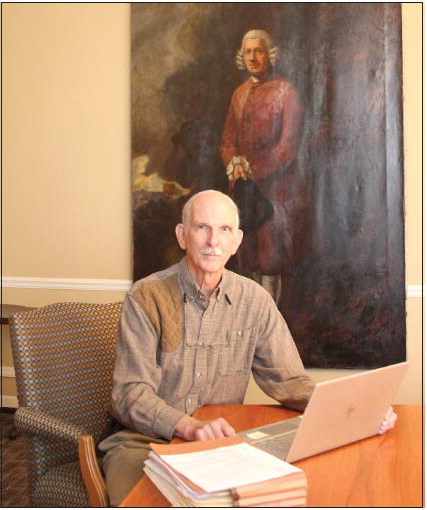
PAVING PROJECT – Vidalia funeral director Ron Hall stands on one of the roads in Pinecrest Cemetery that needs repairs. Hall recently initiated a local fundraising campaign to pave the roads in the historic city cemetery.Photo by Deborah Clark
